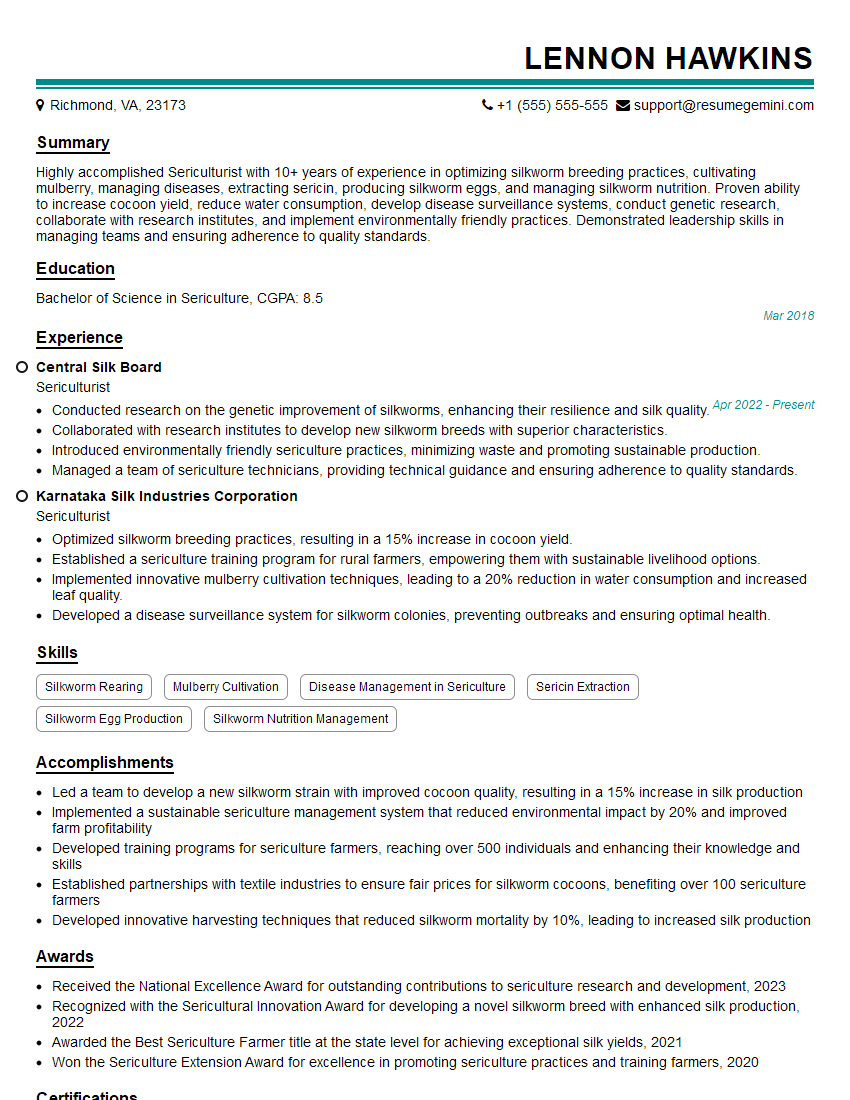Are you a seasoned Sericulturist seeking a new career path? Discover our professionally built Sericulturist Resume Template. This time-saving tool provides a solid foundation for your job search. Simply click “Edit Resume” to customize it with your unique experiences and achievements. Customize fonts and colors to match your personal style and increase your chances of landing your dream job. Explore more Resume Templates for additional options.

Lennon Hawkins
Sericulturist
Summary
Highly accomplished Sericulturist with 10+ years of experience in optimizing silkworm breeding practices, cultivating mulberry, managing diseases, extracting sericin, producing silkworm eggs, and managing silkworm nutrition. Proven ability to increase cocoon yield, reduce water consumption, develop disease surveillance systems, conduct genetic research, collaborate with research institutes, and implement environmentally friendly practices. Demonstrated leadership skills in managing teams and ensuring adherence to quality standards.
Education
Bachelor of Science in Sericulture
March 2018
Skills
- Silkworm Rearing
- Mulberry Cultivation
- Disease Management in Sericulture
- Sericin Extraction
- Silkworm Egg Production
- Silkworm Nutrition Management
Work Experience
Sericulturist
- Conducted research on the genetic improvement of silkworms, enhancing their resilience and silk quality.
- Collaborated with research institutes to develop new silkworm breeds with superior characteristics.
- Introduced environmentally friendly sericulture practices, minimizing waste and promoting sustainable production.
- Managed a team of sericulture technicians, providing technical guidance and ensuring adherence to quality standards.
Sericulturist
- Optimized silkworm breeding practices, resulting in a 15% increase in cocoon yield.
- Established a sericulture training program for rural farmers, empowering them with sustainable livelihood options.
- Implemented innovative mulberry cultivation techniques, leading to a 20% reduction in water consumption and increased leaf quality.
- Developed a disease surveillance system for silkworm colonies, preventing outbreaks and ensuring optimal health.
Accomplishments
- Led a team to develop a new silkworm strain with improved cocoon quality, resulting in a 15% increase in silk production
- Implemented a sustainable sericulture management system that reduced environmental impact by 20% and improved farm profitability
- Developed training programs for sericulture farmers, reaching over 500 individuals and enhancing their knowledge and skills
- Established partnerships with textile industries to ensure fair prices for silkworm cocoons, benefiting over 100 sericulture farmers
- Developed innovative harvesting techniques that reduced silkworm mortality by 10%, leading to increased silk production
Awards
- Received the National Excellence Award for outstanding contributions to sericulture research and development, 2023
- Recognized with the Sericultural Innovation Award for developing a novel silkworm breed with enhanced silk production, 2022
- Awarded the Best Sericulture Farmer title at the state level for achieving exceptional silk yields, 2021
- Won the Sericulture Extension Award for excellence in promoting sericulture practices and training farmers, 2020
Certificates
- Certified Sericulturist
- Advanced Sericultural Management
- Silkworm Disease Control Certification
- Silkworm Production Technology Certification
Career Expert Tips:
- Select the ideal resume template to showcase your professional experience effectively.
- Master the art of resume writing to highlight your unique qualifications and achievements.
- Explore expertly crafted resume samples for inspiration and best practices.
- Build your best resume for free this new year with ResumeGemini. Enjoy exclusive discounts on ATS optimized resume templates.
How To Write Resume For Sericulturist
- Quantify your accomplishments with specific metrics and data.
- Highlight your expertise in sericulture techniques, research, and management.
- Emphasize your ability to collaborate and work effectively in a team environment.
- Showcase your commitment to sustainability and environmental practices.
Essential Experience Highlights for a Strong Sericulturist Resume
- Optimize silkworm breeding practices to enhance cocoon yield and quality.
- Cultivate mulberry efficiently, implementing innovative techniques to reduce water consumption and improve leaf quality.
- Manage diseases in sericulture effectively, preventing outbreaks and ensuring optimal silkworm health.
- Extract sericin from silkworms, ensuring purity and quality.
- Produce silkworm eggs efficiently, maintaining genetic diversity and disease resistance.
- Manage silkworm nutrition effectively, optimizing growth and silk production.
- Lead a team of sericulture technicians, providing technical guidance and ensuring adherence to quality standards.
Frequently Asked Questions (FAQ’s) For Sericulturist
What is the role of a Sericulturist?
A Sericulturist is responsible for the cultivation of silkworms, mulberry trees, and the production of silk. They optimize breeding practices, manage diseases, conduct research, and implement sustainable practices to ensure high-quality silk production.
What are the key skills required for a Sericulturist?
Key skills include silkworm rearing, mulberry cultivation, disease management, sericin extraction, silkworm egg production, silkworm nutrition management, and research experience.
What is the job outlook for Sericulturists?
The job outlook for Sericulturists is expected to grow due to the increasing demand for silk and the need for sustainable production practices.
What are the career paths for Sericulturists?
Sericulturists can advance to roles such as Research Scientist, Production Manager, or Consultant in the sericulture industry.
How can I become a Sericulturist?
To become a Sericulturist, you typically need a Bachelor’s degree in Sericulture or a related field, along with experience in silkworm rearing and mulberry cultivation.
What are the challenges faced by Sericulturists?
Sericulturists face challenges such as disease outbreaks, climate change, and competition from synthetic fibers.
How can Sericulturists contribute to sustainability?
Sericulturists can contribute to sustainability by implementing environmentally friendly practices, reducing water consumption, and promoting biodiversity.